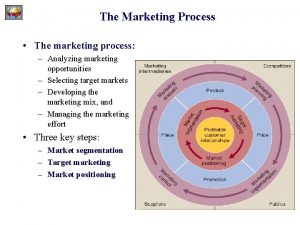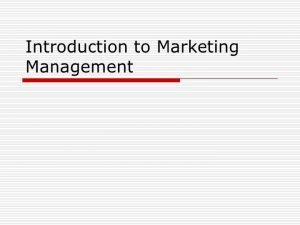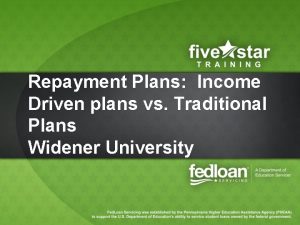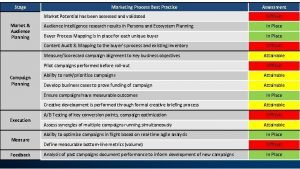MARKETING PLANS THE MARKETING PROCESS Marketing plans have














- Slides: 14

MARKETING PLANS

THE MARKETING PROCESS Marketing plans have either a product-orientation approach or a sales-orientation approach, as outlined in the table below. Marketing Approach Company Goals Company Strategy Product orientation Better products than competitors Company spends more time and money on product component of the marketing mix Sales orientation Encouraging more consumers to buy the product Company spends more time, effort and money on price structure, promotion and placement activities in the marketing mix

The marketing process involves many stages and is a continuous cycle. Marketing is cyclical because most products eventually become outdated and there is a constant demand for new products.

MARKETING MIX The marketing mix is made up of four organised activities: product planning price structure placement or distribution promotion

1. PRODUCT PLANNING The product Life Cycle: shows how a products income generation for a company changes as it progresses through the market phases of: introduction growth maturity decline leading to its ultimate failure.

PRODUCT LIFE CYCLE

2. PRICING STRUCTURES Pricing is an integral part of the marketing plan. Some people are prepared to pay more for a product than others are; it depends on the value they place on it. The best pricing policy allows for consumers to pay more if they see more value in a product — for example, selling the best-quality king prawns for $29. 00 per kilogram while school prawns are $10. 00 per kilogram.

2. PRICING STRUCTURES The product price depends on what the target market is prepared to pay. Characteristics of the target market: age gender socioeconomic level family size education

PRICING TACTICS Penetration pricing Price skimming Competitive pricing Status-quo pricing

ACTIVITY Visit a retail outlet such as a supermarket. Choose one food product that has at least four different brands and is the same size (for example, canned salmon). Identify which target market each product is targeting and record the price of the item. Do you think consumers are paying more for a higher quality item in each case or not? Give reasons for your answer.

3. PROMOTION Promotion informs consumers about new products, and persuades customers to buy a new product or buy more of an existing one. Promotional activities teach us to be consumers. The types of activity include: advertising personal selling publicity and public relations sales promotions (sales, in-store sample testing, product giveaways and demonstrations).

4. PLACE AND DISTRIBUTION Place in the marketing mix refers to where the product will be sold geographically and to the kinds of outlet in which it will be sold. Distribution refers to the process of moving the product from the producer to the consumer.

4. PLACE AND DISTRIBUTION Place is where the target market lives, works, plays and shops. Marketers have several tactics to consider when placing a product to reach the target market. Intensive distribution — means when products are available at every possible outlet (for example, chocolate bars are sold in small shops, service stations, grocery stores, newsagents, bakery shops, vending machines and online) Selective distribution — this is when there is a wide but not intensive distribution (for example, some types of cheese are available at delicatessen chains such as Cut Price Delis rather than Woolworths or Coles) Exclusive distribution — means when a limited supply of a product is sold in only a few retail outlets, usually because the product is expensive (for example, handmade chocolates) and has an elite image in the consumer's mind.

4. PLACE AND DISTRIBUTION Once a company has chosen its placement strategy, the physical distribution of the product takes place. Distribution involves moving the product from the manufacturer to the point of sale. The longer the distribution chain is, the less efficient it is. warehousing materials handling inventory control order processing transportation
 It has 6 rectangular faces, 12 edges and 6 vertices
It has 6 rectangular faces, 12 edges and 6 vertices Hát kết hợp bộ gõ cơ thể
Hát kết hợp bộ gõ cơ thể Slidetodoc
Slidetodoc Bổ thể
Bổ thể Tỉ lệ cơ thể trẻ em
Tỉ lệ cơ thể trẻ em Chó sói
Chó sói Tư thế worms-breton
Tư thế worms-breton Chúa yêu trần thế alleluia
Chúa yêu trần thế alleluia Kể tên các môn thể thao
Kể tên các môn thể thao Thế nào là hệ số cao nhất
Thế nào là hệ số cao nhất Các châu lục và đại dương trên thế giới
Các châu lục và đại dương trên thế giới Công của trọng lực
Công của trọng lực Trời xanh đây là của chúng ta thể thơ
Trời xanh đây là của chúng ta thể thơ Mật thư tọa độ 5x5
Mật thư tọa độ 5x5 Làm thế nào để 102-1=99
Làm thế nào để 102-1=99



























